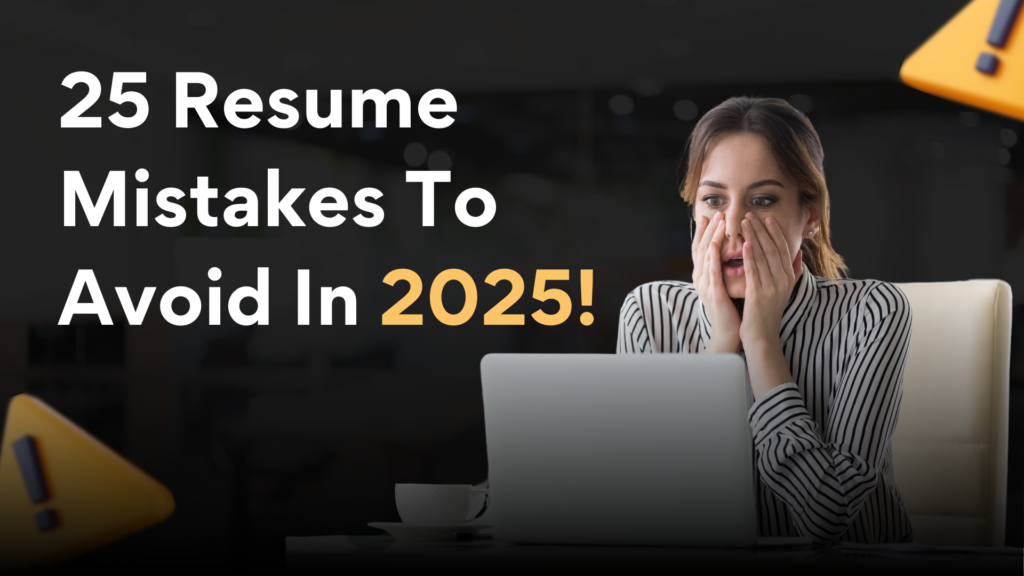25 Resume Mistakes To Avoid In 2025!

Crafting a professional resume is essential to making a lasting impression on recruiters.
However, many job seekers make avoidable mistakes that can hinder their chances of landing an interview.
Here’s a comprehensive guide to the most common resume mistakes and how to avoid them:
1. Avoid Fancy Resume Designs
Ensure your resume design is simple and professional.
Avoid using excessive visuals, graphs, and icons, as they may distract from the content and make it difficult for Applicant Tracking Systems (ATS) to process.
Use clean fonts and minimal colors to maintain focus on your qualifications.
2. Keep It Concise and Within Two Pages
Your resume should be tailored to your experience level.
Freshers should stick to a single page, mid-level professionals can use up to 1.5 pages, and senior-level candidates can extend to two pages.
Avoid exceeding two pages to keep it concise and impactful.
3. Skip the Career Objective Section
The career objective section is outdated and often fails to add value.
Replace it with a professional summary or profile section that highlights your unique qualifications and career goals.
4. Exclude Personal Information
Avoid adding personal details such as marital status, father’s name, or date of birth.
These are irrelevant to the job application and take up unnecessary space.
5. Avoid Tables, Graphs, and Icons
While tables and visuals may look appealing, they can hinder ATS readability.
If you must use them, keep them minimal and straightforward.
6. Customize Your Resume for Each Job
Do not send the same resume to multiple job applications.
Tailor your resume to highlight the skills and experiences most relevant to the specific job role you’re applying for.
7. Focus on Achievements, Not Responsibilities
Simply listing job responsibilities is generic and uninspiring.
Highlight your achievements by showcasing measurable results and the impact you made in your previous roles.
8. Skip Overused Buzzwords
Avoid generic terms like “hardworking” and “team player.”
Instead, use action verbs and specific examples to demonstrate your skills and accomplishments.
9. Remove Unnecessary Sections
Sections like “Declaration” and “References” are outdated. Unless explicitly requested, exclude them to save space.
10. Avoid Adding a Photograph (Unless Required)
Including a photograph is not a common practice in many industries.
Only add one if explicitly required by the job application.
11. Eliminate Typos and Grammar Errors
Errors in your resume signal carelessness.
Proofread thoroughly to ensure it is free of spelling mistakes and grammatical errors.
12. Tailor Your Resume for Each Job
Customize your resume for every job you apply to.
Focus on relevant skills and experiences, and use keywords from the job description to align your resume with the role.
13. Use a Professional Email Address
Your email address should reflect professionalism.
Avoid unprofessional or inactive email IDs and use a format like firstname.lastname@gmail.com.
14. Name Your Resume File Appropriately
Save your resume with a clear and professional file name, such as YourName_Role.pdf.
Avoid generic names like Resume_Final.
15. Be Honest About Your Skills and Experience
Do not exaggerate or lie about your qualifications.
Recruiters can verify your claims during interviews, and dishonesty can damage your credibility.
16. Check Resume Formatting
Ensure your resume formatting remains intact when opened as a PDF or Word document.
Consistency in formatting makes your resume look polished and professional.
17. Avoid Fancy Colors and Fonts
Keep your resume simple and easy to read.
Avoid using excessive colors or complicated fonts, which can distract recruiters and appear unprofessional.
18. Quantify Your Achievements
Whenever possible, include numbers to showcase your accomplishments.
For instance, mention how you increased revenue by 15% or led a team of five members.
19. Avoid Personal Pronouns
Do not use personal pronouns like “I” or “my” in your resume.
Instead, focus on action verbs to describe your accomplishments.
20. Exclude Your Full Home Address
It’s unnecessary to include your complete home address.
Mention only your city and state to keep it concise.
21. Don’t Rely Entirely on AI Tools for Resume Writing
Using tools like ChatGPT for initial drafts is acceptable, but relying on them completely can result in generic resumes.
Personalize and refine your resume to align with your experiences and goals.
22. Avoid Oversharing Personal Hobbies
Only include hobbies if they are relevant to the job or showcase transferable skills.
Avoid listing hobbies like “watching movies” or “cooking” unless they add value to your application.
23. Exclude Irrelevant Work Experience
Focus on experiences relevant to the role you’re applying for.
Irrelevant experiences or outdated achievements can clutter your resume.
24. Use Reliable ATS Tools
Stop relying on generic ATS score tools.
Instead, use trusted tools like Jobscan, which compare your resume against job descriptions to ensure relevance.
25. Include Hyperlinks to Your Portfolio and LinkedIn Profile
Make it easy for recruiters to access your portfolio and LinkedIn profile by including clickable hyperlinks in your resume.
By avoiding these common mistakes, you can create a strong, impactful resume that stands out to recruiters.
Which of these mistakes have you been making? Let’s fix them for a stronger 2025-ready resume!
Related Articles
Recent Posts
Recent Posts
- 0xd148a913
- How We Helped a Planning Engineer Get More Interview Calls with Our Resume Writing Services
- Helped a US-Based Fresher Create Role-Specific Resumes
- Dubai-Based Client Lands Interviews with Our Resume Writing Services
- 100+ Computer Networks Interview Questions
- 70+ Interview Questions for Pharma Industry : Documentation Executive
- 100+ Business Development Inteview Questions
- 100+ Salesforce QA Inteview Questions
- 80+ Real Estate Inteview Questions
- 100+ Supply Chain Management Inteview Questions
Facing constant rejections? Your Resume could be the reason.
You’re losing opportunities every single day because your Resume isn’t up to the mark.
Get a Free Resume Review and a report from our expert.
- Insightful Resume Review
- Given by an Expert Resume Writer
- Detailed PDF with Report and Guidance
